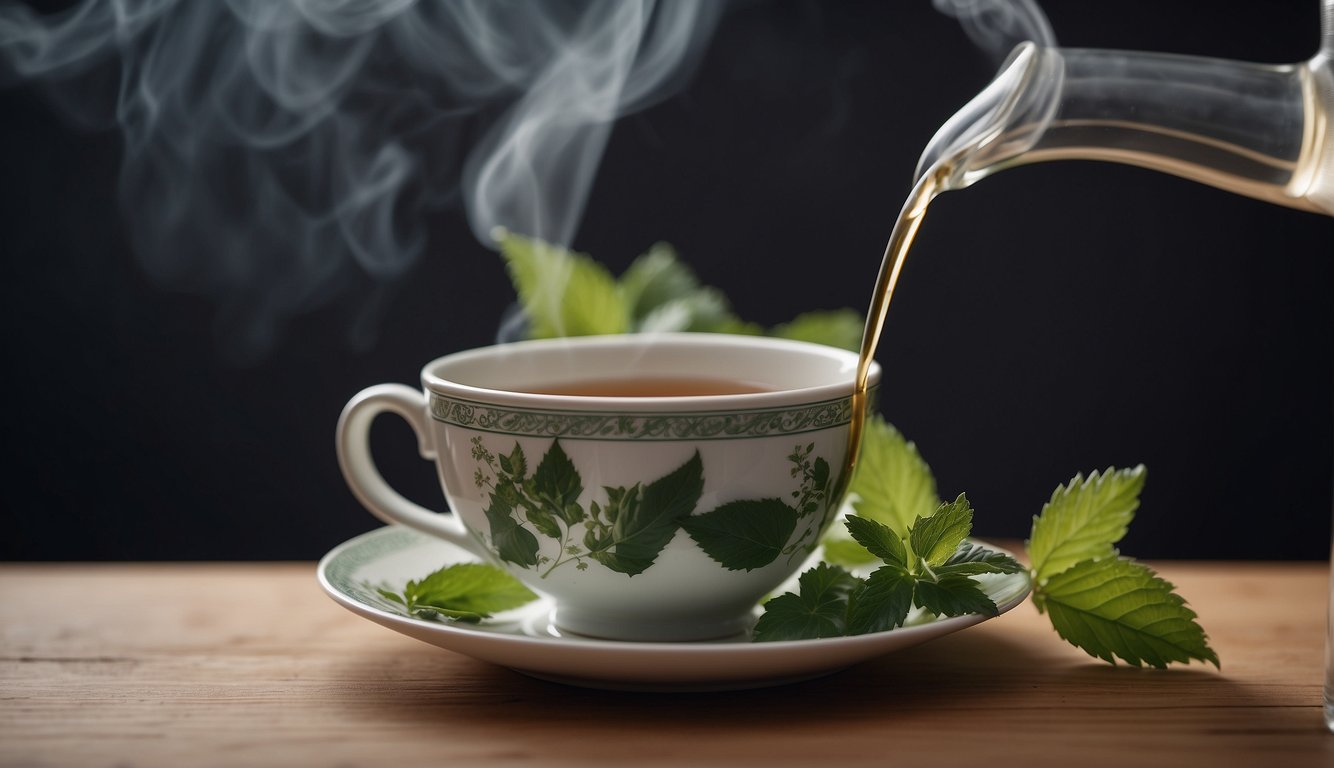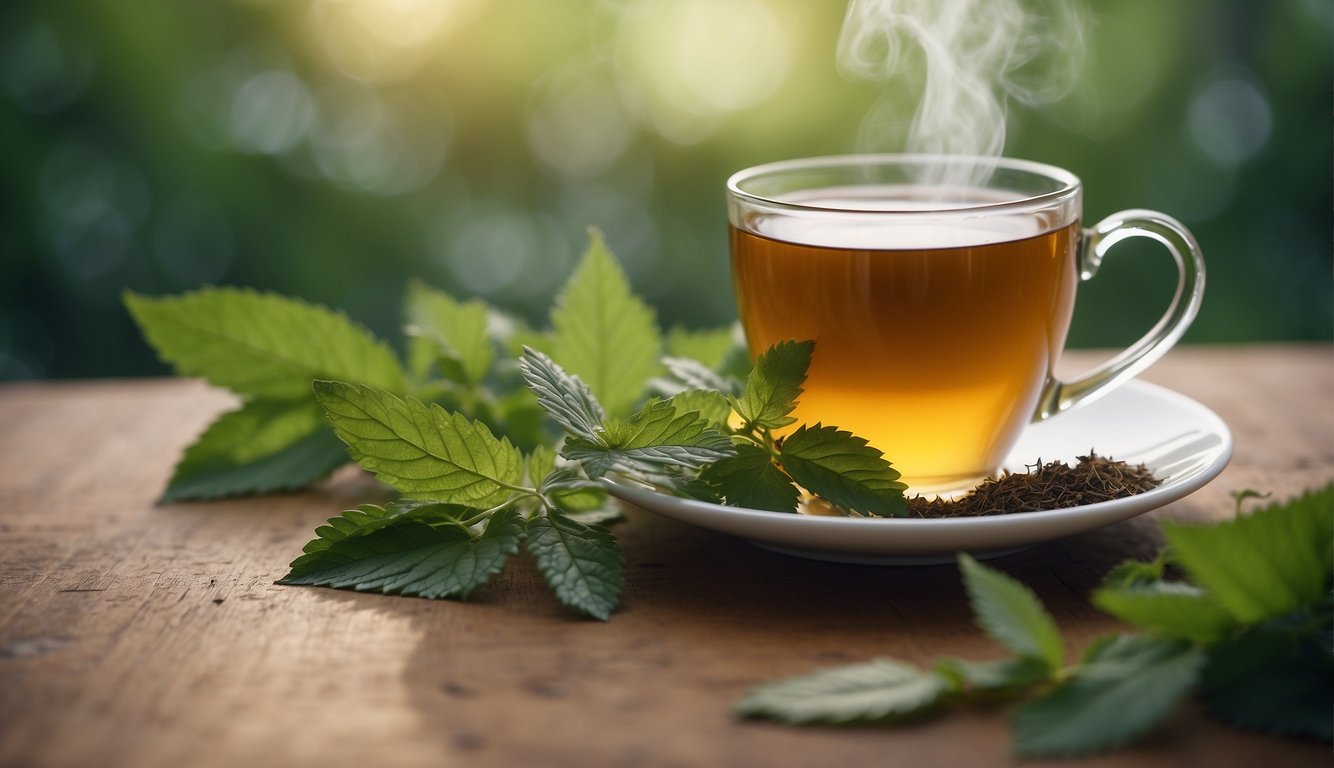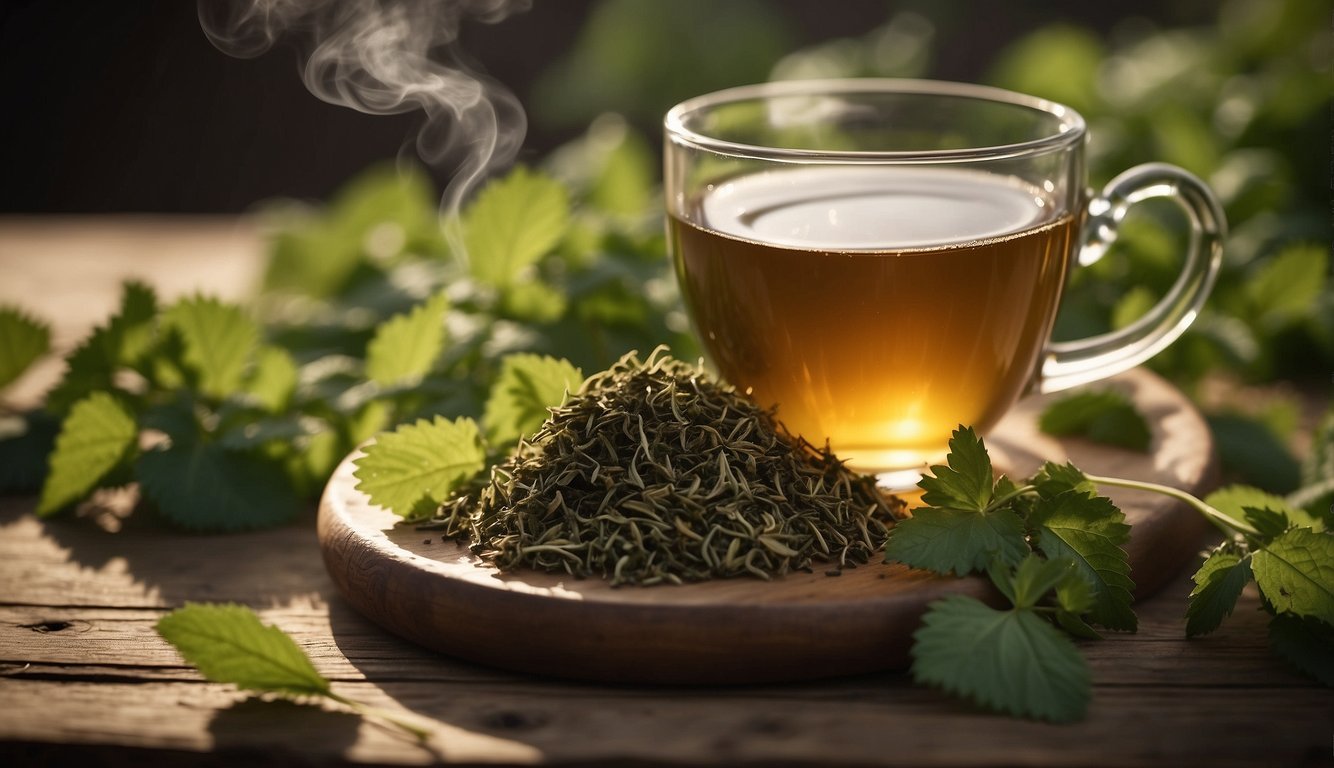TheHerbProf.com is a treasure trove of knowledge for those interested in natural healing and herbal remedies. The website is run by Paul Johnston MD. A naturopathic who has not only received extensive education in the field but also has personal experience in self-healing.
Nettle tea is a herbal drink that has been used for centuries for its medicinal properties. But what are the nettle tea benefits? It is made from the leaves of the stinging nettle plant, also known as Urtica dioica. Nettle tea is known for its anti-inflammatory, antioxidant, and nutritional properties.
Drinking nettle tea regularly may have several health benefits. It is believed to help with arthritis, allergies, BPH, and urinary tract health. Nettle tea may also aid in blood sugar management and chronic disease prevention. However, it is important to note that more research is needed to fully understand the potential benefits of nettle tea.
Historical Background of Nettle Tea

As a tea, nettle has been consumed for centuries, and it has a rich history in both Asia and Europe. In this section, I will discuss the origins of nettle tea and its traditional uses in herbal medicine.
Origins in Asia and Europe
Nettle is native to Europe, Asia, and North Africa, and it has been used for food and medicine for thousands of years. According to Gaia Herbs, nettle was used by the ancient Greeks and Romans to treat a variety of ailments, including joint pain, allergies, and respiratory issues. In medieval Europe, nettle was used to make a type of cloth called “nettle cloth,” which was said to be stronger and more durable than cotton.
Traditional Uses in Herbal Medicine
Nettle has been used in herbal medicine for centuries, and it is still used today to treat a variety of ailments. According to a study published in the Journal of Food Science and Technology, nettle has a wide range of nutritional and pharmacological benefits. It is rich in vitamins and minerals, and it has been shown to have anti-inflammatory, antioxidant, and antimicrobial properties.
In traditional herbal medicine, nettle was used to treat a variety of conditions, including arthritis, allergies, and urinary tract infections. It was also used as a diuretic and to promote lactation in nursing mothers. Nettle tea was often used to treat respiratory issues, such as coughs and bronchitis, and it was said to be particularly effective in treating seasonal allergies.
Overall, nettle tea has a long and rich history in both Asia and Europe, and it has been used for centuries to treat a variety of ailments. Its traditional uses in herbal medicine are still relevant today, and it continues to be a popular tea around the world.
Nutritional Profile of Nettle Tea

Nettle tea is a healthy beverage that is rich in essential vitamins, minerals, and antioxidants. Here’s a closer look at the nutritional profile of nettle tea:
Vitamins and Minerals Content
Nettle tea is an excellent source of vitamins and minerals, including iron, calcium, magnesium, potassium, and vitamin C. According to Medical News Today, a single tea bag of nettle leaf tea, when brewed, delivers:
- Calories: 1
- Protein: 0 grams
- Fat: 0 grams
- Carbohydrates: 0 grams
- Fiber: 0 grams
Presence of Antioxidants and Flavonoids
Nettle tea is also rich in antioxidants and flavonoids, which are compounds that have been shown to have a range of health benefits. According to Healthline, nettle tea contains high levels of the following antioxidants and flavonoids:
- Quercetin
- Kaempferol
- Caffeic acid
- Coumarins
- Lignans
These compounds have been shown to have anti-inflammatory, antimicrobial, and anticancer properties. Additionally, nettle tea is also rich in carotenoids, which are powerful antioxidants that can help protect the body against damage from free radicals.
Nettle tea is a healthy beverage that is rich in essential vitamins, minerals, and antioxidants. It is a great way to boost your overall health and wellbeing, and it is easy to make at home.
Health Benefits of Nettle Tea
Nettle tea has been used for centuries as an herbal medicine and has been found to have numerous health benefits. In this section, I will discuss some of the most significant health benefits of nettle tea.
Anti-Inflammatory Effects
Nettle tea contains natural compounds that have anti-inflammatory properties. These compounds can help reduce inflammation in the body, making nettle tea a potential remedy for conditions such as arthritis and osteoarthritis. Studies have shown that nettle tea can help reduce joint pain and improve joint mobility in people with osteoarthritis.
Blood Sugar Regulation
Nettle tea may also help regulate blood sugar levels, making it a potential remedy for people with type 2 diabetes. Studies have shown that nettle tea can help lower blood sugar levels in people with type 2 diabetes. Additionally, nettle tea is a natural diuretic, which means it can help flush excess sugar from the body through urine.
Promotion of Heart Health
Nettle tea may also promote heart health by helping to lower blood pressure. High blood pressure is a risk factor for heart disease, and nettle tea has been found to have blood pressure-lowering effects. Additionally, nettle tea is rich in antioxidants, which can help protect the heart from damage caused by free radicals.
Support for Urinary Tract Health
Nettle tea has been traditionally used as a remedy for urinary tract infections. Studies have shown that nettle tea has antibacterial properties that may help prevent the growth of bacteria that can cause urinary tract infections. Additionally, nettle tea is a natural diuretic, which means it can help flush out bacteria from the urinary tract.
Boosting the Immune System
Nettle tea is rich in antioxidants, which can help boost the immune system by protecting the body against free radicals. Free radicals are unstable molecules that can damage cells and contribute to the development of chronic diseases. By neutralizing free radicals, nettle tea may help reduce the risk of developing chronic diseases such as cancer and heart disease.
Nettle tea has numerous health benefits that make it a potential remedy for a variety of conditions. From its anti-inflammatory properties to its ability to regulate blood sugar levels, nettle tea is a natural way to improve your health and well-being.
Potential Therapeutic Uses

Stinging nettle tea has been used for centuries as a natural remedy for various health conditions. Here are some potential therapeutic uses of nettle tea:
Managing Arthritis and Joint Pain
Nettle tea may help manage arthritis and joint pain. According to a study published in the Journal of Ethnopharmacology, nettle leaf extract has anti-inflammatory properties that can help reduce pain and inflammation associated with arthritis [1].
Alleviating Allergies and Hay Fever
If you suffer from allergies or hay fever, drinking nettle tea may help alleviate your symptoms. Nettle tea contains compounds that can help reduce allergic reactions and inflammation, such as histamine and quercetin [2]. A study published in the Journal of Herbal Pharmacotherapy found that nettle extract was effective in reducing symptoms of allergic rhinitis [3].
Improving Digestive Health
Nettle tea may also help improve digestive health. It can act as a natural diuretic and help flush out toxins from the body. Additionally, nettle tea can help stimulate the production of digestive enzymes and bile, which can aid in digestion and prevent constipation [4].
Supporting Prostate Health
Nettle tea may also be beneficial for supporting prostate health. Benign prostatic hyperplasia (BPH) is a common condition that affects many men as they age. According to a study published in the Journal of Herbal Pharmacotherapy, nettle root extract can help reduce the symptoms of BPH, such as frequent urination and difficulty urinating [5].
Overall, nettle tea has many potential therapeutic uses. However, it is important to note that more research is needed to fully understand its effects on different health conditions.
[1] https://www.ncbi.nlm.nih.gov/pmc/articles/PMC6100552/ [2] https://www.healthline.com/ [3] https://pubmed.ncbi.nlm.nih.gov/19140159/ [4] https://www.medicalnewstoday.com/ [5] https://pubmed.ncbi.nlm.nih.gov/14729012/
Preparation and Usage

As with any tea, the preparation of nettle tea is a crucial step in ensuring maximum flavor and benefits. Here are some tips to help you brew the perfect cup of nettle tea.
Brewing the Perfect Cup of Nettle Tea
To brew nettle tea, you’ll need to start with dried nettle leaves. You can find them at most health food stores or online. To make the tea, simply add 2-3 teaspoons of dried nettle leaves to a teapot or infuser. Then, pour boiling water over the leaves and let them steep for 5-10 minutes. Strain the tea and enjoy!
If you prefer a stronger flavor, you can add more nettle leaves to your tea. You can also add other herbs or spices to your tea to enhance the flavor. For example, honey, cinnamon, or lemon can all be added to nettle tea to give it a unique taste.
Recommended Dosage and Frequency
The recommended dosage for nettle tea is 2-3 cups per day. However, it’s important to note that nettle tea can have diuretic effects, so you may want to limit your intake if you’re prone to dehydration. Additionally, if you’re pregnant or breastfeeding, you should consult with your healthcare provider before drinking nettle tea.
Nettle tea can also be consumed in other forms, such as tinctures or infusions. However, it’s important to follow the recommended dosage instructions for each form of nettle tea to ensure safety and efficacy.
Overall, nettle tea is a delicious and healthy beverage that can provide numerous benefits for your health. By following these simple tips for preparation and usage, you can enjoy all the benefits of nettle tea in a safe and effective way.
Safety and Side Effects

Nettle tea is generally considered safe for consumption. However, there are a few possible side effects that you should be aware of.
Possible Interactions with Medications
If you are taking any medications, it is important to talk to your doctor before consuming nettle tea. Nettle tea may interact with certain medications, including diabetes medications, diuretics, and nonsteroidal anti-inflammatory drugs (NSAIDs). It is also important to note that nettle tea may affect blood sugar levels, so it is important to monitor your blood sugar levels closely if you are diabetic.
Considerations for Pregnant Women
Pregnant women should also exercise caution when consuming nettle tea. While nettle tea is generally considered safe for consumption during pregnancy, there is some evidence to suggest that it may stimulate uterine contractions and increase the risk of miscarriage. As a result, pregnant women should consult with their doctor before consuming nettle tea.
In rare cases, some people may experience an allergic reaction to nettle tea. Symptoms of an allergic reaction may include hives, itching, and difficulty breathing. If you experience any of these symptoms after consuming nettle tea, you should seek medical attention immediately.
Overall, nettle tea is a safe and healthy beverage that can provide a number of health benefits. However, it is important to exercise caution when consuming nettle tea, particularly if you are taking any medications or if you are pregnant. If you experience any side effects or have any concerns about consuming nettle tea, you should consult with your doctor.
Comparative Analysis

Nettle Tea vs. Other Herbal Teas – Get Organic Nettle Leaf Herbal Tea Here.
When it comes to herbal teas, there are a lot of options out there. However, nettle tea stands out due to its unique flavor and health benefits. Compared to other herbal teas, nettle tea has a distinct earthy taste that some people may find bitter. However, it is still a popular choice due to its potential health benefits.
One key difference between nettle tea and other herbal teas is the nutritional content. Nettle leaves are rich in vitamins and minerals, including vitamins A, C, and K, calcium, iron, and magnesium. This makes nettle tea a great choice for those looking to boost their nutrient intake.
Another difference is the potential health benefits. While many herbal teas have health benefits, nettle tea is particularly well-known for its potential to alleviate seasonal allergies, reduce inflammation, and improve prostate health. Additionally, some studies have suggested that nettle tea may have anti-cancer properties, although more research is needed to confirm this.
Scientific Research on Nettle Tea Benefits
There have been several scientific studies on the potential health benefits of nettle tea. One study published in the Journal of Herbal Medicine found that nettle tea may be effective in treating eczema, a common skin condition. Another study published in the Journal of Ethnopharmacology found that nettle tea may have anti-inflammatory properties, which could make it useful in treating conditions such as arthritis.
Research has also suggested that nettle tea may have immune-boosting properties. A study published in the Journal of Medicinal Food found that nettle tea may help stimulate the immune system, potentially making it useful in preventing and treating infections.
Overall, while more research is needed to fully understand the potential health benefits of nettle tea, the existing research suggests that it may be a useful addition to a healthy diet. Whether you’re looking to boost your nutrient intake or alleviate seasonal allergies, nettle tea is definitely worth considering.
Additional Uses of Nettle

Nettle has been used for centuries for various purposes, including medicinal, culinary, and textile. Apart from its use as a tea, nettle has other potential benefits that are yet to be fully explored. In this section, I will discuss some of the additional uses of nettle.
Nettle in Skincare and Cosmetics
Nettle is known for its anti-inflammatory properties, which make it a suitable ingredient for skincare products. It is believed that the use of nettle in cosmetics can help reduce the appearance of fine lines and wrinkles, improve skin elasticity, and soothe irritated skin. Nettle is also rich in antioxidants, which can help protect the skin from damage caused by free radicals.
Some skincare products that contain nettle include toners, face masks, and serums. Nettle can also be used as a natural remedy for certain skin conditions such as eczema, acne, and psoriasis. However, it is important to note that more research is needed to determine the effectiveness of nettle in treating these conditions.
Use of Nettle in Lactation and Women’s Health
Nettle has been traditionally used as a galactagogue, which is a substance that increases milk production in lactating women. Nettle is believed to stimulate the production of prolactin, a hormone that is responsible for milk production. However, more research is needed to confirm this claim.
Nettle is also believed to have uterine-stimulating properties, which make it useful in inducing labor and regulating menstrual cycles. However, pregnant women are advised to avoid nettle as it can cause uterine contractions, which may lead to premature labor.
Nettle has a wide range of potential uses beyond its use as a tea. It can be used in skincare products and as a natural remedy for certain skin conditions. Nettle is also believed to have galactagogue properties, making it useful for lactating women. However, pregnant women should avoid nettle due to its uterine-stimulating properties.
Linking Nettle to TheHerbProf.com
Nettle is a powerful herb with a range of health benefits, and at TheHerbProf.com, we’re all about exploring these benefits! Here’s how our website and this subject harmonize:
- Nettle Narratives: We provide comprehensive information about nettle, its medicinal properties, and its uses in herbal medicine.
- Herbal Highlights: Our site offers insights into how nettle can be incorporated into your herbal regimen.
- Safety Measures: We guide you on how to use nettle safely and effectively.
- Health and Wellness: Our focus is on promoting overall health and wellness, and nettle plays a crucial role in this.
- Community Connection: Connect with others who are passionate about nettle and share your experiences.
So, whether you’re a nettle enthusiast or just starting your herbal journey, TheHerbProf.com is your trusted guide. Remember, stay curious and stay healthy!
References:
Little Herb Encyclopedia, by Jack Ritchason; N.D., Woodland Publishing Incorporated, 1995
The Ultimate Healing System, Course Manual, Copyright 1985, Don Lepore
Planetary Herbology, Michael Tierra, C.A., N.D., Lotus Press, 1988
Handbook of Medicinal Herbs, by James A. Duke, Pub. CRP Second Edition 2007
The Complete Medicinal Herbal, by Penelope Ody, Published by Dorling Kindersley
Before You Go – Check the Following Articles!
Frequently Asked Questions – Nettle Tea Benefits

What are the health advantages of consuming nettle tea for the skin?
Nettle tea is known to have anti-inflammatory properties that can help soothe and calm irritated skin. It may also help in reducing acne and eczema outbreaks. Nettle tea can be applied topically or consumed orally to enjoy its benefits. However, it is important to note that more research is needed to fully understand the effects of nettle tea on the skin.
How does nettle tea impact hormonal balance?
Nettle tea is believed to have a positive impact on hormonal balance, particularly in women. It contains compounds that may help regulate estrogen levels and reduce symptoms of premenstrual syndrome (PMS). Nettle tea may also improve prostate health in men by reducing the size of the prostate gland.
Can nettle tea improve hair health and how?
Nettle tea is rich in vitamins and minerals that are essential for healthy hair growth. It may help reduce hair loss and dandruff, improve hair texture, and promote shinier hair. Nettle tea can be used as a hair rinse or consumed orally to enjoy its benefits.
What is the optimal time to consume nettle tea for maximum benefits?
There is no specific time to consume nettle tea for maximum benefits. However, it is recommended to consume it regularly to experience its full range of benefits. Nettle tea can be consumed at any time of the day, either hot or cold.
In what ways can nettle tea contribute to weight loss?
Nettle tea may help in weight loss by reducing water retention, increasing metabolism, and suppressing appetite. It is also low in calories and can be a healthy alternative to sugary drinks. However, it is important to note that nettle tea alone cannot lead to significant weight loss and should be combined with a healthy diet and exercise.
Are there any risks associated with drinking nettle tea during pregnancy?
Nettle tea is generally considered safe during pregnancy when consumed in moderation. However, it is important to consult with a healthcare provider before consuming nettle tea during pregnancy, as it may cause uterine contractions and other complications. Pregnant women should also avoid consuming nettle tea in large amounts.


